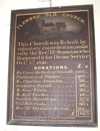For this church:    |
|
|
donations board |
It appears initially to have been built in the Norman period, though much of the older church no longer exists. There was a buttressed western tower of 3 stages, the lower two being 14th century and the upper possibly 15th century, this is derived from a panel showing a painted view of the old church, of unknown date.
The nave had a lead roof with a rich Norman doorway of three orders on the south side, and a two-light window of the early 14th century. A former, steeper, roof line was visible on the east elevation of the tower. There were two 15th century windows in the south side of the chancel, and this portion of the building had what appears to be a pantile roof.
The doorway previously mentioned has been given a date of c1150.
The chancel had a high pitched tiled roof with two square-headed windows of late 14th century date and an east window, which still remain and retain parts of old tracery. There is a plain pointed piscina niche in the south wall of the chancel.
The church is not recorded in the 1291 taxation of Pope Nicholas IV, nor does it feature in the 1341 Nonae Rolls. This is unsurprising as the church formed a chapelry variously to Shelton and Staunton. At the 1428 subsidy there is also no mention of the church, though it is interesting to note that Shelton (in which parish it may have lain as in 1419 appurtenances were recorded as such in the Close Rolls) failed to respond to the question of valuation. In 1316 William de Staunton held the fiefdom of Flawborough.
In 1523-8 the church was taxed as ‘Flawborough stipendiary chaplaincy’ as part of Henry VIII's clerical subsidy.
In 1602 the churchwardens presented that the ‘chancel is decayed in the slate, but whether it should be repaired by the parson or by the town, they cannot present’, and the following year: ‘the chancel is out of repair, but the inhabitants are purposed to repair it speedily’. Despite this promise, six years later, in 1609, they reported ‘the chancel for want of tiling, in default of the parish’. By 1616 things had not improved much as they again reported ‘our chapel for being out of repair because “the welte [or wette] did fall so sodenlie that it could not be mended”; we entreat that the town be given some time for repairing of the chapel, and it shall be repaired presently if the weather serves it’.
The registers of the church date from 1680.
At the time of Archbishop Herring's visitation in 1743, St Peter was part of Staunton Church, and was returned as such. The same was the case at Archbishop Drummond’s Visitation in 1764. In 1764 the Rev George Staunton Brough reported that the chapel at Flawborough was two miles distant from the parish church of Staunton, but he served it every Sunday, either morning or afternoon alternatively.
The church was rebuilt in 1840, for which there is an inscription over the west doorway. Features still remain of the old building, including two orders of colonnettes and zigzag arches. The new parts were built in stucco-covered brick, consisting of chancel, nave, and western tower. On a panel under the tower, there is an inscription that reads ‘This church was rebuilt by voluntary contributions, assisted by the Reverend D Staunton, who re-opened it for Divine Service October 3rd 1841’, along with a list of subscriptions, including those from the Duke of Newcastle of £105, parishioners of £100 and Dr Staunton of £300. The total amount raised was £769 3s 0d as well as £66 1s 0d from the sale of old materials.
In 1844 Flawborough paid a church-rate of one third to Staunton, though the livings of Staunton with Flawborough and Kilvington were united by this date.
In 1851 the chapelry had a population of 40 males and 40 female the church could accommodate 19 people ‘all appropriated’.
In 1892, £200 was spent on restorations including re-seating. The floor was raised and re-laid, a north vestry formed and heating apparatus fixed. There was seating accommodation for 100. Bishop Ridding, who visited in 1892, regarded the restoration as adequate.
The church was partially in the parish of Orston. Formerly a small modus in lieu of tithes was paid for that parish, with another to Shelton. However, by the 19th century the rector of Staunton claimed and retained the whole of the tithes, though his portion was limited to £60 a year by an agreement made in medieval times.
The living was a chapelry annexed to the rectory of Staunton. In 1881 it had a joint yearly value of £322 in the gift of, and held by, the Rev. Francis Staunton, M.A. of St. John’s College, Cambridge. In 1895, it had an average tithe rent-charge of £224 and joint net yearly value of £290, with 137 acres glebe. It had been held since 1888 by the Rev Fredrick John Ross until 1926, when the Rev George William Staunton, who was also rector of Kilvington, held the living, though resided in Staunton.
In 1912 the church was returned as having 100 sittings. Eight children were on the Sunday School roll, and there had been one baptism in the previous twelve months.
The church was officially closed for worship on 1st February 2009 and the parish of Flawborough became part of Staunton parish, and it has now been sold into private hands.







